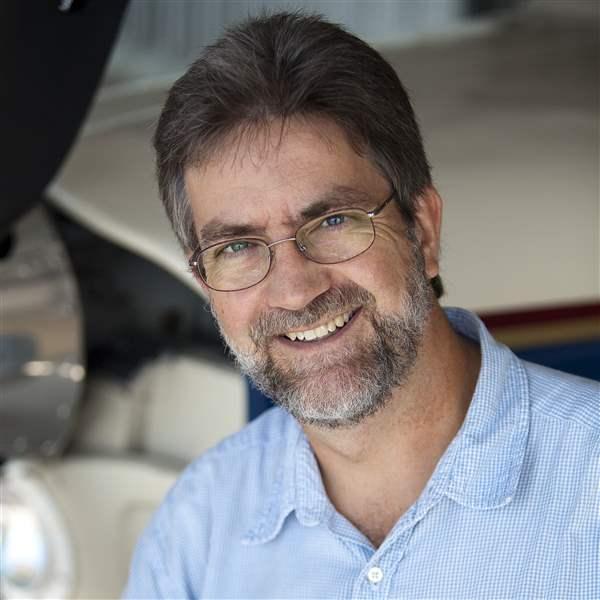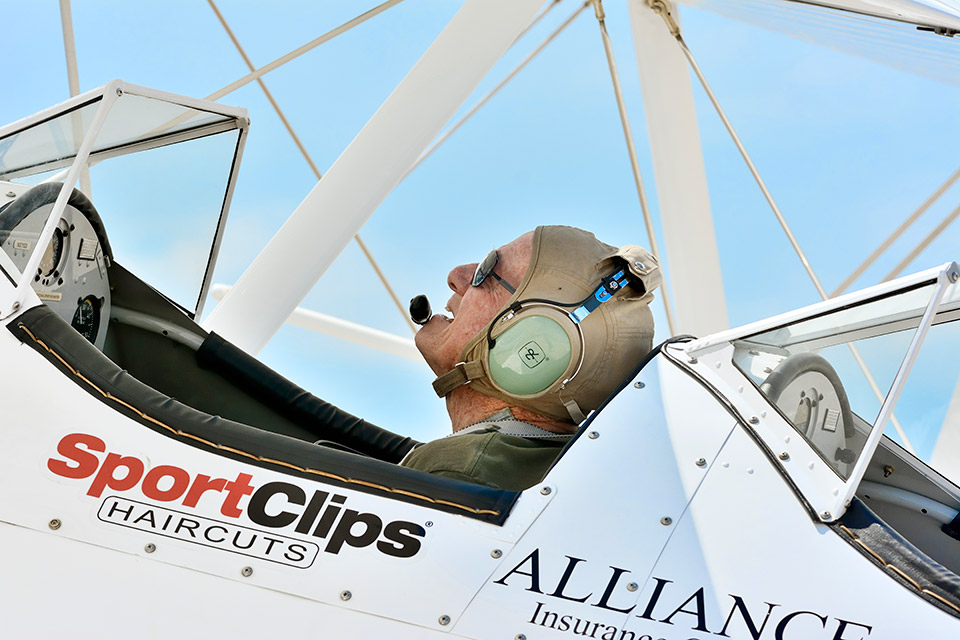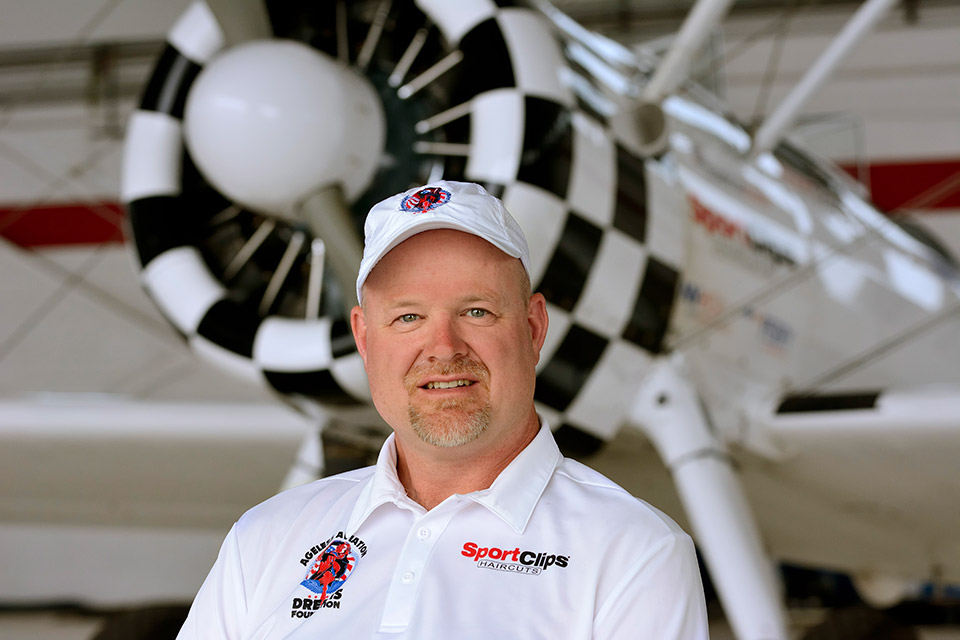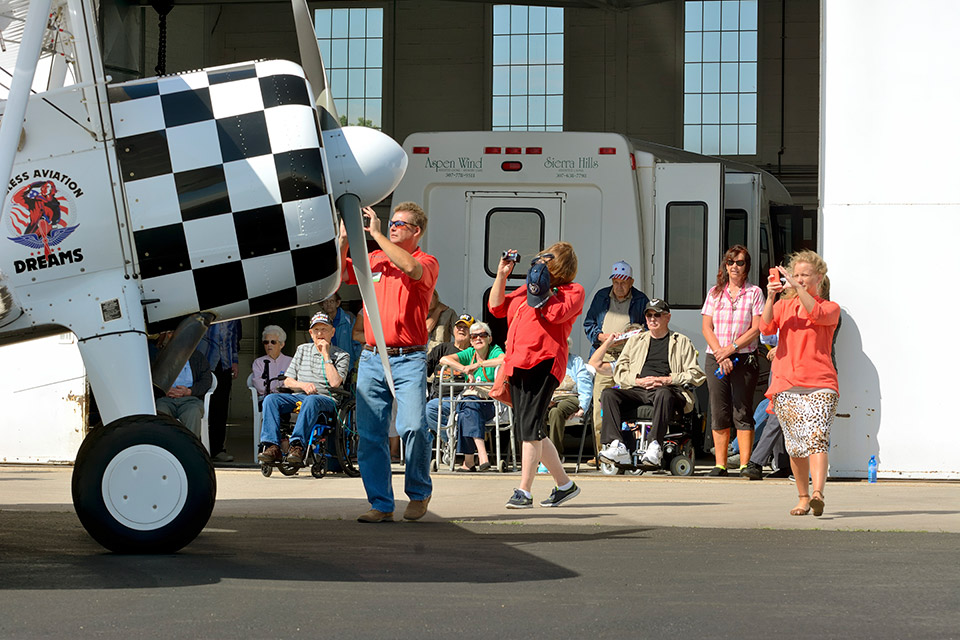The white-and-black-checkered Stearman already had made half a dozen flights from Centennial Airport, just south of Denver, on the cool August morning, so the 450-horsepower Pratt & Whitney R-985 Wasp Junior fired quickly—with just a cough and a couple puffs of gray smoke.
As the biplane taxied toward the runway, Quentin West, 91, relaxed in the front cockpit, tilting his head back and savoring the moment.
West was in the U.S. Army from 1942 to 1946, reaching the rank of sergeant. He served in the Pacific theater, sometimes flying Aeroncas, and flew Stearmans in 1947 after he got out of the military. But he hadn’t flown in a Stearman for nearly seven decades, and the airplane appeared to fit him like a familiar glove.
He was the last passenger of the day for the Ageless Aviation Dreams Foundation, a nonprofit created in 2011 to honor senior veterans from all the U.S. armed forces with Dream Flights in one of three restored World War II-era Stearmans. The group flew its 1,000th passenger on Memorial Day 2015, and conducted 1,510 flights through the end of 2015.
“Something very interesting happens when you load one of the veterans into that airplane,” said Darryl Fisher, pilot for today’s flights—and founder and president of the foundation. “Many times they don’t say much; they’re very stoic—a little apprehensive, a lot of times—and something changes between the time you leave and the time you come back. I’ve seen it too many times.
“They’ve got big smiles on their faces—and they just start talking,” Fisher said. “Families say, ‘We’ve never heard these stories—ever,’ and, ‘Dad didn’t like to talk about this.’ They’re just in awe because they didn’t know their father was involved in those kinds of things; they didn’t know that he risked his life in certain ways. And the veterans are talking about that openly. It’s just magic.”
During World War II Edgar Riehl, 94, flew 55 missions as a B–25 co-pilot. “We were known as the ‘Treetop Airmen,’” he said after his flight. “We flew low-level strafing missions, and had to get up to 75 feet above the ground when we released our parafrag bombs—so the spinners had time to spin off and arm them—then we were right back down on the deck again.” On one mission flak disabled half of his Mitchell’s flight-control system, and the crew counted 245 holes in the airplane—but nobody was injured.
Riehl had flown Stearmans in pilot training. “This PT–17 was stiffer on the controls than I remembered, but I was told that’s because of the larger engine on this one.” (Most Stearmans were built with 220-horsepower powerplants.) After the war he flew in the Berlin Airlift and, later, for United Airlines, where he retired from the Boeing 747 in 1980.
Mitch Mischlar, 92, completed his missions as a B–17 gunner on March 8, 1944. He then was trained in the B–29, although the war ended before he could be sent to the Pacific theater. He later served as a crew chief and flight engineer on the C–54 and C–124, including tours in Vietnam and Laos.
“[Fisher] turned the airplane over to me for about 10 minutes. I flew it nice and level. A little gusty, but I kept it right side up,” Mischlar said. “It was really one of the most enjoyable rides I’ve ever had—and I didn’t get shot at.”
It was Rex Ploen’s first time at the controls since he served in the Marine Corps, flying combat missions in Corsairs and Hellcats. “I enjoyed it,” he said. “Nobody was shooting at me. You don’t need that much excitement.” Ploen, 92, said he logged more than 100 carrier landings. “It was always good to get back.”
•••
“I wish that this had been a brainchild of mine from day one, but it wasn’t,” Fisher said. Both his grandfather and grandmother were pilots, and his grandfather bought a Stearman in 1946. “When I was 2 years old, they bought a nursing home—so I grew up around aviation, and old people. And I developed both of those passions.”
Fisher became a senior executive for a large national company in the senior care field. “We had a program that we called Ageless Dreams, and the idea was to make a dream happen for one of our residents, at least, in every community, once per month—because dreams don’t die when you get old. And it was an incredible program.”
In 2008 the company was sold. “I ran it through a reorganization in 2010, and our Ageless Dreams program died,” he said. “It didn’t carry over to the new company, and that was very disappointing to me.”
Fisher found that he had a lot of time on his hands. He also had two Stearmans, and in 2011, Fisher’s father asked him to help fly his own Stearman home to Oregon following a rebuild in Cleveland, Mississippi.
“We’d always dreamed of barnstorming together,” Fisher recalled. “I got to thinking about our Ageless Dreams program, and I got to thinking about our trip. I called my dad and said, ‘Hey, do you mind if on our gas stops, we give one or two residents dream flights on our way back?’” Their first stop was in Oxford, Mississippi, where Hugh Newton—a radar operator in World War II—made the first dream flight on March 29, 2011. “His wife came over to me afterward and said, ‘You don’t realize what you’ve just done for Hugh.’”
The next morning, they were on the front page of the local newspaper. “We gave 25 flights on our way back to Oregon, and at every stop, we had that kind of experience. We got home and my wife said, ‘We need to form a 501(c)(3). You can’t stop doing this.’”
•••
Two days after Ageless Aviation Dreams visited Denver, Fisher and Tim Newton—a volunteer pilot then checking out in the foundation’s Stearman, and a former Air Force F–16 pilot now flying Boeing 777s internationally as a first officer for FedEx—were in Cheyenne, Wyoming, for another round of dream flights.
John Wilkinson, 92, flew Spitfires for the Royal Air Force during World War II. In 1942 he received primary instruction in the Stearman, in Florida. “The Stearman was quite a big, well-built biplane that you could do all the aerobatics in—that’s where I learned the basics of aerobatics.”
Wilkinson was ecstatic to have the opportunity to take the stick again. “I…did a bit of everything I could do without violating their insurance, as far as aerobatics went,” he said. “It was fun—I just loved it. I hadn’t done it in I don’t know how many years.”
During the war he was credited with shooting down three Focke-Wulf Fw 190s, as well as a V–1 “buzz bomb.” Stationed in Copenhagen, Denmark, after the war, he and a friend pioneered close-formation aerobatics and performed aerial demonstrations in the Spitfire Mk. XIV. Later he moved to the United States and joined a flying club, where he flew Cessna 152s and 172s. “But that was kind of tame, so I didn’t stay for long.”
Eddie Amend, 87, served as a communications officer in the Air Force during the Korean War. He used his GI Bill benefits to earn a private pilot certificate, and he still flies radio-controlled model aircraft. “This was my first time in an open-cockpit plane, and it was a marvelous experience,” he said. “Of course, I wanted the opportunity to fly. I made a gentle, wide circle around the city of Cheyenne. It was fun to see things from the air again.”
Amend’s daughter was teary-eyed after he was strapped into the biplane. “He’s driving 600 miles for this,” she said. “It means so much to him.”
•••
The foundation, which relies completely on donations, operates three Stearmans—based in Mesa, Arizona; San Antonio, Texas; and Kissimmee, Florida—and is raising funds to purchase a fourth. “We have wonderful donors. I’m not personally independently wealthy. We all donate our time; we keep flying so long as we have money. So far, we’re doing great.” Sponsors include Sport Clips, Matrix Care, and Direct Supply. Fisher was sitting in Chicago’s O’Hare International Airport when he got an email from Sport Clips’ veterans affairs person that said, “I see what you’re doing—it’s awesome. How can we help?”
If Fisher’s enthusiasm for the program is any indication, its future is bright. “It’s an unbelievable experience. It’s almost indescribable because what you’re giving these people—they never think they’ll ever fly again, ever, let alone in a biplane. And when you give that to them, it brings up memories of their past—it’s universally exciting. I never get tired of it. It’s never a burden—and I’ve been doing this for five years now.”
Email [email protected]
For more information on the Ageless Aviation Dreams Foundation, see the website.










